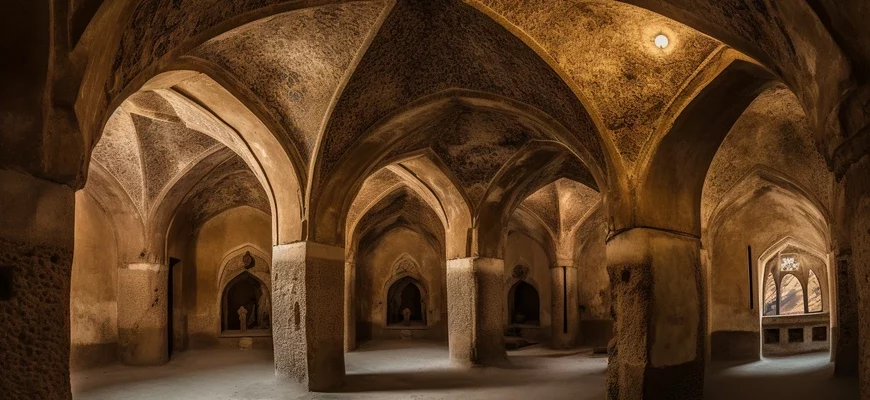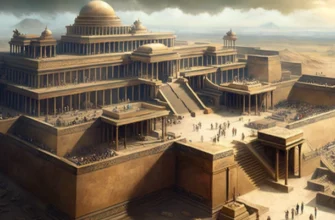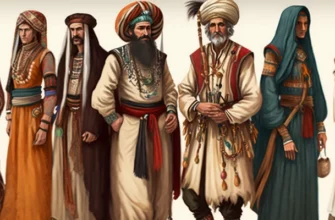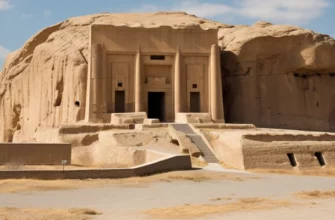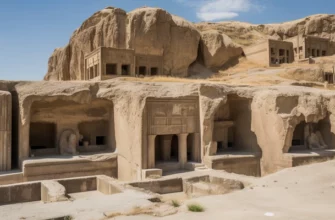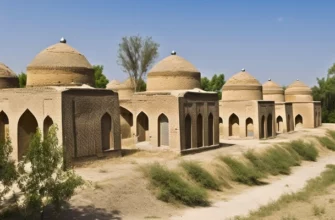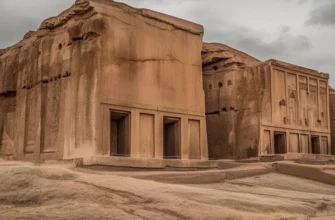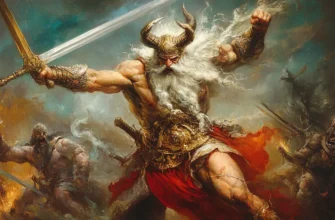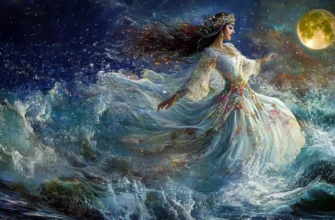Ancient Iranian culture has a long history and rich development. Its art, architecture, religion, and other aspects influenced neighboring peoples and left their mark on modern world culture. This article examines the culture of ancient Iran from ancient times to the Arab conquest in the 7th century AD.
- The art of ancient Iran
- Rock and object paintings
- Metalworking and pottery
- Weaving and embroidery
- Architecture of ancient Iran
- Zigzag staircases and mausoleums
- Palace complexes and temples
- Cave cities
- Religion in Ancient Iran
- Rituals and shrines
- Influence on other religions
- Society and culture of ancient Iran
- The fall of ancient Iran
- Arab conquest in the 7th century AD
- Contemporary perception of the culture of ancient Iran
- Conclusions: the significance of ancient Iranian culture for the present day
The art of ancient Iran
The art of ancient Iran has its own characteristics and uniqueness. Rock and object paintings, metalworking and pottery, weaving and embroidery are the main types of art in Iran. The paintings depict scenes from biblical stories and everyday life, known as “Persian miniatures.” Metalworking and pottery were highly valued for their craftsmanship and unsurpassed beauty. Weaving and embroidery, made with gold and silk, are also characteristic of ancient Iran.
Rock and object paintings
Rock and object paintings are one of the most characteristic elements of ancient Iranian art. These paintings depicted various scenes from biblical stories as well as the daily life of the people. They are known as “Persian miniatures” and are renowned for their beauty and detail. The artists of ancient Iran used natural paints for their paintings, which have survived to this day and allow us to appreciate the high skill and creativity of the ancient artists.
Metalworking and pottery
Metalworking and pottery were highly valued in ancient Iran for their craftsmanship and beauty. Craftsmen created complex metal products such as weapons, tableware, and jewelry using a variety of techniques, including forging and casting. Pottery was also a very popular craft, and craftsmen created a variety of products, from simple pots to complex vases and sculptures. In many cases, these items were decorated with various ornaments and reliefs, which made them even more valuable and popular among the population.
Weaving and embroidery
Weaving and embroidery are characteristic art forms of ancient Iran. Craftsmen used various materials, including silk, wool, and cotton, to create a variety of products, including carpets, clothing, and towels. Silk products decorated with gold and silver are particularly well known, giving them a look of glamour and luxury. Embroidered patterns that adorned clothing and textiles are also well known. Craftsmen used a variety of colors and techniques to create unique and beautiful items that still impress with their beauty and craftsmanship.
Architecture of ancient Iran
The architecture of ancient Iran was diverse and had its own characteristics. It reflected the cultural and religious influences that intersected in Iran. The main types of buildings were palaces, mosques, mosque-mausoleums, minarets, as well as Zoroastrian temples and observation towers. Architects used stone and brick to construct buildings that had complex shapes and were decorated with rich reliefs and ornaments. Courtyards and fountains were also popular, providing coolness in the hot climate. Many of these buildings have survived to this day and have become popular tourist attractions.
Zigzag staircases and mausoleums
Staircases with varying slopes and mausoleums are characteristic elements of ancient Iranian architecture. Staircases with varying slopes, also known as “zigzag staircases,” were used to climb to the top of hills or fortresses. Such stairs can be found in many places in Iran, for example, in Persepolis and Susa. Mausoleums, also called mausoleums, were built as burial places for important people, such as rulers and their relatives. They had complex architectural forms and were decorated with various ornaments and reliefs. The most famous of these are the Mausoleum at Halicarnassus and the Mausoleum at Fars.
Palace complexes and temples
Palace complexes and temples are an important part of ancient Iranian architecture. Palace complexes such as Persepolis and Susa were the center of political and social life during the Achaemenid Empire. They had a complex layout and were decorated with reliefs and ornaments. Temples, especially Zoroastrian temples, were places of worship and religious rituals. They had simple architectural forms and were oriented to the southeast to face the sun, which played an important role in the Zoroastrian religion. The most famous temples are the Fire Temple in Zarathustra and the Temple of Angel Mithra in Tisfon.
Cave cities
In ancient Iran, there were many cave cities that have survived to this day. These cities were usually located in mountainous areas, where local residents found refuge from enemy attacks and stored their food from the heat.
One of the most famous cave cities in Iran is Bam, located in the province of Kerman. Bam consists of several thousand caves that were used for housing, storing grain, and food. This city was founded about 2,000 years ago and became an important point on the trade routes between India and Europe.
Other famous cave cities in Iran include Meybod, Kandovan, and Natanz. Meybod was founded about 1,800 years ago and contains many cave buildings, such as mosques, baths, and harems.
Kandovan was founded around 1,500 years ago and consists of many caves that were used for housing and grain storage. This city is an ancient center of textiles and weaving in Iran.
Natanz was founded around 1,000 years ago and contains many cave buildings such as mosques, caravanserais, and harems.
It is also famous for its arts and crafts, particularly carpet making.
All of these cities are excellent examples of cave dwellings and architecture in Iran, and they remain popular tourist destinations.
Religion in Ancient Iran
Ancient Iran was dominated by Zoroastrianism, a religion that originated in Iran more than 3,500 years ago. Zoroastrianism was a belief system that assumed the existence of two opposing forces of good and evil, each striving to defeat the other. These two forces were known as Ahura Mazda and Angra Mainyu.
Zoroastrianism also attached great importance to fire and water, considering them symbols of purity and holiness. In Zoroastrianism, paying respect to the dead was of great importance, and the belief was accompanied by the use of turbans, which became a symbol of the Zoroastrians.
In the 7th century BC, during the reign of the Achaemenid dynasty, Iran became more tolerant of other religions, and other beliefs, such as Judaism and Christianity, appeared in the country.
Throughout Iran’s history, religious conflicts have been inevitable, but Zoroastrianism has remained an important element of Iranian culture and faith, influencing art, architecture, and other aspects of culture. Today, Zoroastrianism is the religion of only a small number of Iranians, but its legacy remains part of Iran’s culture and history.
Rituals and shrines
Zoroastrianism was associated with many rituals and shrines, some of which are still important to Iranians today.
One of the main rituals was Yasna, which took place every year in honor of the god Ahura Mazda. This ritual consisted of four parts, including singing, prayers, and sacrifices.
Another important ritual was “Navruz,” which was celebrated in the spring and accompanied by competitions, dancing, and food. It was a holiday that symbolized rebirth and a new beginning.
One of the most famous shrines of Zoroastrianism is “Atashgah,” a place where fire was worshipped. These shrines were located in many cities in Iran and were built according to strict rules and rituals.
Another important place was the “Dahma,” a place where the traditional Zoroastrian ritual cremation of the dead was performed.
In Zoroastrianism, spiritual teachers, known as “mobeeds,” were also of great importance. These people were responsible for conducting religious ceremonies and teaching other believers.
The shrines and rituals of Zoroastrianism are still preserved in Iran today, although attendance and practice of this religion have declined significantly in recent decades.
Influence on other religions
The ancient religion of Iran, particularly Zoroastrianism, played an important role in the development of religious and cultural traditions not only in Iran but also in many other parts of the world.
For example, Zoroastrian ideas about the struggle between good and evil, free will, and moral responsibility influenced the teachings of Judaism, Christianity, and Islam. Many of the concepts associated with these religions today have their roots in Zoroastrianism, such as the idea of the Last Judgment, heaven, and hell, which reflect the concept of spiritual positive and negative.
Zoroastrianism also influenced the religious and cultural identity of the Iranian people, as well as their art and literature. Many traditional Iranian holidays are related to the Zoroastrian religion, such as the holiday of Nowruz.
In addition, Zoroastrianism influenced the development of spiritual and moral philosophy, particularly in late antiquity and the Middle Ages. For example, the Indian philosophical teachings of Buddhism and Jainism reflect the ideas of responsibility for one’s actions and their impact on one’s destiny.
Thus, the religion of ancient Iran played an important role in shaping the religious and cultural traditions of many peoples, as well as in the development of philosophical and moral thought.
Society and culture of ancient Iran
Ancient Iranian society was divided into two social classes: the nobility and the common people. The nobility consisted of noble families and princes who held high positions in the state and were landowners. The common people, in turn, were engaged in crafts, agriculture, and trade. Overall, society was military-feudal, and power was in the hands of princes and nobles.
The culture of ancient Iran was multi-layered and multifaceted. The Iranian artistic tradition reflected religious and national characteristics. The main areas of culture were literature, architecture, music, art, and folk customs.
The literature of ancient Iran was linked to religion and mythology. One of the most famous works is the Avesta, the sacred book of Zoroastrianism, which includes religious and philosophical texts. Iranian literature was also associated with epics and legends, such as the Shahnameh, an epic work on the history of Iran.
The architecture of ancient Iran was characterized by the use of luxurious materials and intricate ornamentation. The most famous architectural monuments are Persepolis and Pasargadae, the two capitals of the Achaemenid Empire.
The music and art of ancient Iran also reflected religious and national characteristics. Traditional Iranian music included the use of instruments such as the tar (drum), setar (stringed instrument), and dutar (another stringed instrument). Choirs singing in the Iranian language were also used in music.
The folk customs of ancient Iran were associated with the celebration of various holidays and religious rites. For example, the holiday of Nowruz (New Year) was one of the biggest holidays in Iran and was celebrated from March 21 to 24. Another important holiday was Yalda, which was celebrated on the day of the winter solstice. Religious holidays such as prayers to fire, which took place at bonfires (atashgahs), were also well known.
All these aspects of Iranian culture and society played an important role in shaping national identity and preserving Iranian culture to this day.
The fall of ancient Iran
Ancient Iran was repeatedly conquered and lost its independence, but one of the most significant events in its history was the fall of the Achaemenid Empire.
In the 4th century BC, the Persian Empire was conquered by Alexander the Great and became part of his vast empire. After Alexander’s death, Persia became a hereditary principality held by Greco-Bactrian and Parthian rulers.
In the 3rd century BC, power over Persia passed to the Parthian Empire, which went down in history as the Persian Empire. Under the Parthian dynasty, the Zoroastrian religion was restored and attempts were made to preserve Persian culture.
However, in the 7th century, Persia was conquered by the Arab Caliphate and became part of the Islamic world. After several centuries of Arab rule, Persia became a distinct ethnic and cultural region, preserving its unique character and culture.
In the 20th century, a series of revolutions and coups allowed Iran to regain its independence and create a new form of government. Today, Iran is a republic with a rich history and culture.
Arab conquest in the 7th century AD
In the 7th century AD, Persia was conquered by Arab invaders during the Islamic expansion. The Persian Empire, which at that time controlled a significant part of the Middle East, was conquered by Muslim Arabs over several decades.
In 632, after the death of the Prophet Muhammad, Muslim conquest began to rapidly expand beyond the borders of Arabia. From 633 to 651, Arab forces launched a campaign of conquest in the Middle East, subjugating the Persian and many other empires.
In 651, the Persian Shah Yazdgerd III was defeated by the Arab commander Khalid ibn al-Walid, after which Persia became part of the Umayyad Caliphate. Although the Persian elites already had strong ties to Islam at that time, the conversion to Islam was slow, and some parts of the Persian community, who considered themselves descendants of Zoroastrian priests, did not convert to Islam.
After the conquest of Persia by Arab conquerors, the Persian people began to gradually adapt to Islam and Arab culture. The traditional Zoroastrian worldview is gradually disappearing, although some of its elements have been preserved in Iranian folk art and folklore. From Islamic culture, Iran has acquired new forms of architecture, literature, art, and science.
Contemporary perception of the culture of ancient Iran
The contemporary perception of the culture of ancient Iran is quite complex and measured. On the one hand, Iran has deep roots in ancient Persian culture, which played an important role in world history. Iranians proudly honor their past and respect the legacy of their ancestors. Ancient Persian language, literature, art, and science continue to be studied and used in Iran and around the world.
On the other hand, the modern Iranian state, which was established after the fall of the Pahlavi dynasty in 1979, is considered a conservative Islamic republic. In academic circles and in discussions on the culture of Iran, there is often debate about the conflict between Iranian national heritage and the Islamic religion introduced by the conquerors from Arabia. This conflict has to contend with feelings of national dignity and religious identity.
Overall, the culture of ancient Iran is of great importance for understanding world history and the cultural development of humanity. Modern Iranians and researchers of Iranian folk culture continue to explore and honor the heritage of their ancestors and preserve it for future generations.
Conclusions: the significance of ancient Iranian culture for the present day
The significance of ancient Iranian culture for the present lies in its multifaceted heritage, which has an impact on various areas of life.
First, ancient Persian culture is important for the development of science and technology. Iranian scientists have made global achievements in scientific fields, including astronomy, physics, mathematics, and other areas.
Second, the culture of ancient Iran is important for the development of art. Iranian music, dance, and traditional art have a great influence on the culture of the Middle East and Central Asia.
Third, the culture of ancient Iran is an integral part of Iranian national consciousness and identity. Iranians preserve and honor their cultural past and traditions, which allows them to maintain their national dignity and identity.
Thus, the culture of ancient Iran is of great importance to the present day, contributing to the development of science and technology, art, and preserving the national identity and consciousness of Iranians.
